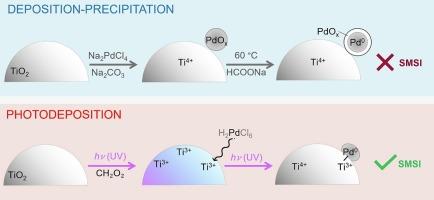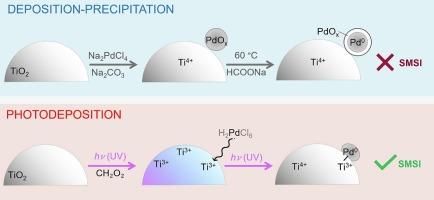Pd/TiO2中强金属-载体相互作用的起源
IF 6.5
1区 化学
Q2 CHEMISTRY, PHYSICAL
引用次数: 0
摘要
强金属-载体相互作用(SMSI)是稳定金属纳米粒子(NPs)在可还原性金属氧化物上的关键因素,影响其分散性、形态和催化性能。在本研究中,我们发现调整合成方案可以制备具有明显不同金属-载体相互作用的Pd/TiO2催化剂,并研究了这些变化背后的潜在机制。沉积-沉淀法制备的催化剂表现出弱的Pd-TiO2相互作用,而光沉积法制备的催化剂则表现出明显的SMSI效应。后一种样品即使在高温氧化条件下也表现出显著的金属相稳定性,这对于Pd NPs来说是不寻常的。一项综合的多技术研究将SMSI效应归因于电子顺磁共振(EPR)和电子能量损失(EELS)光谱检测到的Pd/TiO2界面上Ti3+位点的存在,以及光沉积Pd/TiO2催化剂中x射线吸收光谱(XAS)数据观察到的Pd - ti直接相互作用。由于Pd NPs的形成机制不同,这些特征在沉积-沉淀法中没有观察到。本文章由计算机程序翻译,如有差异,请以英文原文为准。


Origin of the strong metal-support interaction in Pd/TiO2
Strong metal-support interaction (SMSI) is a crucial factor in stabilizing metal nanoparticles (NPs) on reducible metal-oxides, affecting their dispersion, morphology, and catalytic properties. In this study, we show that tuning the synthesis protocol allows for the preparation of Pd/TiO2 catalysts with distinctly different metal-support interactions, and we investigate the underlying mechanisms behind these variations. Catalysts prepared via deposition–precipitation exhibit weak Pd-TiO2 interactions, whereas an evident SMSI effect is observed in the ones prepared by photodeposition. The latter samples demonstrate remarkable stability of the metallic phase even under high-temperature oxidizing conditions, unusual for Pd NPs. A comprehensive multi-technique study allowed attributing the SMSI effect to the presence of Ti3+ sites at the Pd/TiO2 interface, detected by electron paramagnetic resonance (EPR) and electron energy loss (EELS) spectroscopies, and direct Pd‒Ti interactions, observed in X-ray absorption spectroscopy (XAS) data, in the photodeposited Pd/TiO2 catalyst. These features were not observed in the case of the deposition–precipitation method, due to the distinct formation mechanisms of the Pd NPs.
求助全文
通过发布文献求助,成功后即可免费获取论文全文。
去求助
来源期刊

Journal of Catalysis
工程技术-工程:化工
CiteScore
12.30
自引率
5.50%
发文量
447
审稿时长
31 days
期刊介绍:
The Journal of Catalysis publishes scholarly articles on both heterogeneous and homogeneous catalysis, covering a wide range of chemical transformations. These include various types of catalysis, such as those mediated by photons, plasmons, and electrons. The focus of the studies is to understand the relationship between catalytic function and the underlying chemical properties of surfaces and metal complexes.
The articles in the journal offer innovative concepts and explore the synthesis and kinetics of inorganic solids and homogeneous complexes. Furthermore, they discuss spectroscopic techniques for characterizing catalysts, investigate the interaction of probes and reacting species with catalysts, and employ theoretical methods.
The research presented in the journal should have direct relevance to the field of catalytic processes, addressing either fundamental aspects or applications of catalysis.
 求助内容:
求助内容: 应助结果提醒方式:
应助结果提醒方式:


